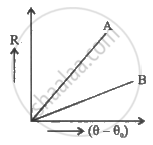Advertisements
Advertisements
प्रश्न
A body cools from 80 °C to 50 °C in 5 minutes. Calculate the time it takes to cool from 60 °C to 30 °C. The temperature of the surroundings is 20 °C.
उत्तर १
According to Newton’s law of cooling, we have:
`- (dT)/(dt) = K(T - T_0)`
`(dT)/(K(T-T_0)) = -kdt` ...(i)
Where,
Temperature of the body = T
Temperature of the surroundings = T0 = 20°C
K is a constant
Temperature of the body falls from 80°C to 50°C in time, t = 5 min = 300 s
Integrating equation (i), we get:
`int_50^80 (dt)/(K(T - T_0)) = -int_0^300Kdt`
`[log_e(T-T_0)]_50^80 = -K[t]_0^300`
`2.3026/K log_10 (80-20)/(50-20) = -300`
`2.3026/K =log_10 2 = -300` ....(ii)
The temperature of the body falls from 60°C to 30°C in time = t’
Hence, we get:
`2.3026/K log_10 (60-20)/(30-20) = -t`
`-2.3026/t log_10 4 = K` ...(iii)
Equating equations (ii) and (iii), we get:
`-2.3026/t log_10 4 = (-2.3026)/300 log_10 2`
:.t = 300 x 2 = 600 s = 10 min
Therefore, the time taken to cool the body from 60°C to 30°C is 10 minutes.
उत्तर २
According to Newton's law of cooling, the rate of cooling is proportional to the difference in temperature.`
Here Average of `80 ^@C` and `50 ^@C = 65 ^@C`
Temperature of surroundings = `20^@C`
:. Difference = `65 - 20 = 45 ^@C`
Under these condition. the body cools `30^@C` in time 5 minutes
`:. "Change in temp"/"Time" = K triangleT` or `30/5 = K xx 45^@` .. (1)
The average of `60^@C` and `30^@` is `45^@C` which is `25^@C`(45 - 20) above the room temperature anf the bodycppls by `30^@C`(60 - 30) in time t (say)
`:. 30/t = K xx 25` ...(ii)
Where K is same for this situation as for the original.
Dividing equation i by ii we get
`="30/5"/"30/t" = (Kxx45)/(Kxx25)`
or `t/5 = 9/5`
`=> t = 9 min`
APPEARS IN
संबंधित प्रश्न
On a cold winter night you are asked to sit on a chair. Would you like to choose a metal chair or a wooden chair? Both are kept in the same lawn and are at the same temperature.
Answer the following question.
State Newton’s law of cooling and explain how it can be experimentally verified.
A bucket full of hot water cools from 85 °C to 80 °C in time T1, from 80 °C to 75 °C in time T2 and from 75 °C to 70 °C in time T3, then ______.
Rate of cooling of a body is 0.4 °C/min when excess temperature is 20 °C. The proportionality constant is ______.
A metal sphere cools from 66° C to 57° C in 10 minutes and to 44° C in the next 10 minutes. The ratio of fall of temperature of first 10 minutes to next ten minutes is ____________.
A liquid with a certain surface area takes 10 minutes to cool from 80° C to 70° C. The time taken by it to cool from 80° C to 60° C is [The surrounding temperature being 40° C] ____________.
A tub of hot water cools from 80°C to 75°C in time t1 from 75°C to 70°C in time t2, and from 70°C to 65°C in time t3 then:
Two circular discs A and B with equal radii are blackened. They are heated to the same temperature and are cooled under identical conditions. What inference do you draw from their cooling curves?

A cup of coffee cools from 90°C to 80°C in t minutes, when the room temperature is 20°C. The time taken by a similar cup of coffee to cool from 80°C to 60°C at a room temperature same at 20°C is ______.
In 5 minutes, a body cools from 75°C to 65°C at a room temperature of 25°C. The temperature of the body at the end of the next 5 minutes is ______°C.
